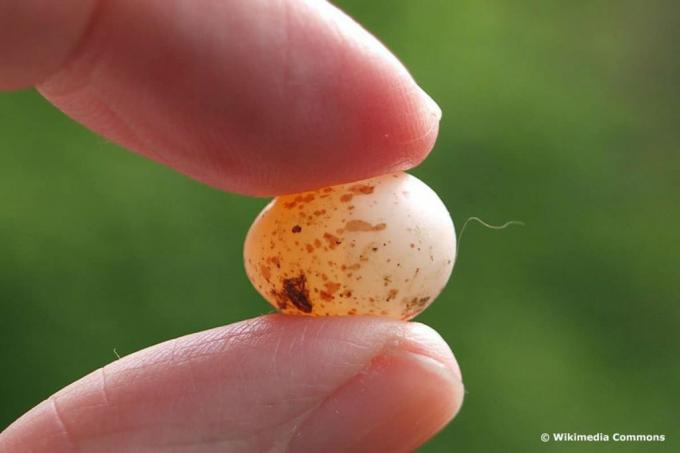
table of contents
- The nesting place
- The clutch
- The look
- frequently asked Questions
The tits (Paridae) are in Europe with different ways widespread. In their habitat the titmice look for burrows as a nesting place. But what color are the tit eggs?
In a nutshell
- in Germany, great tit, blue tit, marsh tit and willow tit dominate
- the birds prefer naturally sheltered nesting sites in tree hollows
- the color of the eggs is characterized by a white background and red-brown spots
- between six and twelve eggs belong to a normal clutch
The nesting place
The birds look for holes in trees or nest boxes to incubate their tit eggs. Before mating, the tits look for their nesting place. They attach great importance to dense undergrowth and natural protection.
Note: The titmouse's nesting site is often near fruit trees. The insects there belong to the preferred food.

The clutch
Six to twelve tit eggs belong to a normal brood. The size is between 13 and 18 mm. The females lay their eggs in the nest within 24 hours. If it is too cold at the time of the year, the females stop laying their eggs. The female incubates the clutch while the male is responsible for feeding.
Note: However, the female initially warms up her brood slightly. Over time, the female devotes herself more and more to breeding. The duration of the brood is between 10 and 17 days.
The look
The tit eggs have a special appearance. The bottom of the tit eggs is white. There is a variable pattern on it. Often, brick-red or red-brown patterns appear in the following ways:
- stains
- Blobs
- Speckles
Tit eggs are very different. Some drawings are evenly distributed over the entire egg, while in other eggs the red blobs are completely absent. Other options are as follows:

- concentrated at the pole of the eggs
- rough pattern
- fine pattern
- sparse or copious splotches of color
Tip: Anyone looking to identify tit eggs should look at the big picture. The white ground and the red-brown resp. Brick red patterns are typical. The rest can confidently differ.
frequently asked Questions
Tits mate in Europe between February and April. During mating, the cohesion between males and females is great. Nevertheless, there is frequent foreign copulation, so that almost every third brood has offspring from other fathers. Copulation takes place in the early hours of the morning near the previously inspected breeding cave.
The tit family includes over 50 different species. In addition to the great tit, the following specimens are also common in our regions:
- Coal tit
- Marsh tit
- Willow tit
- Blue tit
In the maximum case there were clutches with up to 17 eggs. The habitat is responsible for the different clutch sizes. In deciduous forests, tits lay the most eggs, while in parks there are significantly fewer.
